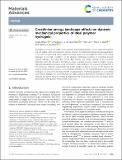| dc.contributor.author | Khare, Eesha | |
| dc.contributor.author | de Alcântara, Amadeus C. S. | |
| dc.contributor.author | Lee, Nic | |
| dc.contributor.author | Skaf, Munir S. | |
| dc.contributor.author | Buehler, Markus J. | |
| dc.date.accessioned | 2024-09-13T15:13:57Z | |
| dc.date.available | 2024-09-13T15:13:57Z | |
| dc.date.issued | 2024-01-22 | |
| dc.identifier.issn | 2633-5409 | |
| dc.identifier.uri | https://hdl.handle.net/1721.1/156723 | |
| dc.description.abstract | Reversible crosslinkers can enable several desirable mechanical properties, such as improved toughness and self-healing, when incorporated in polymer networks for bioengineering and structural applications. In this work, we performed coarse-grained molecular dynamics to investigate the effect of the energy landscape of reversible crosslinkers on the dynamic mechanical properties of crosslinked polymer network hydrogels. We report that, for an ideal network, the energy potential of the crosslinker interaction drives the viscosity of the network, where a stronger potential results in a higher viscosity. Additional topographical analyses reveal a mechanistic understanding of the structural rearrangement of the network as it deforms and indicate that as the number of defects increases in the network, the viscosity of the network increases. As an important validation for the relationship between the energy landscape of a crosslinker chemistry and the resulting dynamic mechanical properties of a crosslinked ideal network hydrogel, this work enhances our understanding of deformation mechanisms in polymer networks that cannot easily be revealed by experiment and reveals design ideas that can lead to better performance of the polymer network at the macroscale. | en_US |
| dc.publisher | Royal Society of Chemistry | en_US |
| dc.relation.isversionof | https://doi.org/10.1039/D3MA00799E | en_US |
| dc.rights | Creative Commons Attribution-Noncommercial | en_US |
| dc.rights.uri | https://creativecommons.org/licenses/by-nc/3.0/ | en_US |
| dc.source | Royal Society of Chemistry | en_US |
| dc.title | Crosslinker energy landscape effects on dynamic mechanical properties of ideal polymer hydrogels | en_US |
| dc.type | Article | en_US |
| dc.identifier.citation | Mater. Adv., 2024,5, 1991-1997 | en_US |
| dc.contributor.department | Massachusetts Institute of Technology. Laboratory for Atomistic and Molecular Mechanics | |
| dc.contributor.department | Massachusetts Institute of Technology. Department of Materials Science and Engineering | |
| dc.contributor.department | Massachusetts Institute of Technology. School of Architecture and Planning | |
| dc.contributor.department | Massachusetts Institute of Technology. Media Laboratory | |
| dc.contributor.department | Massachusetts Institute of Technology. Center for Computational Science and Engineering | |
| dc.relation.journal | Materials Advances | en_US |
| dc.eprint.version | Final published version | en_US |
| dc.type.uri | http://purl.org/eprint/type/JournalArticle | en_US |
| eprint.status | http://purl.org/eprint/status/PeerReviewed | en_US |
| dspace.date.submission | 2024-09-06T15:45:56Z | |
| mit.journal.volume | 5 | en_US |
| mit.license | PUBLISHER_CC | |
| mit.metadata.status | Authority Work and Publication Information Needed | en_US |
